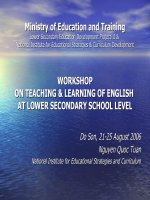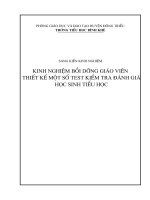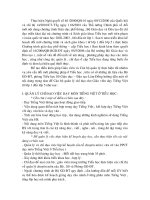Boi duong GV THCS
Bạn đang xem bản rút gọn của tài liệu. Xem và tải ngay bản đầy đủ của tài liệu tại đây (310.05 KB, 59 trang )
Ministry of Education and Training
Ministry of Education and Training
Lower Secondary Education Development Project-II &
Lower Secondary Education Development Project-II &
National Institute for Educational Strategies & Curriculum Development
National Institute for Educational Strategies & Curriculum Development
WORKSHOP
WORKSHOP
ON TEACHING & LEARNING OF ENGLISH
ON TEACHING & LEARNING OF ENGLISH
AT LOWER SECONDARY SCHOOL LEVEL
AT LOWER SECONDARY SCHOOL LEVEL
Do Son, 21-25 August 2006
Do Son, 21-25 August 2006
Nguyen Quoc Tuan
Nguyen Quoc Tuan
National Institute for Educational Strategies and Curriculum
National Institute for Educational Strategies and Curriculum
Theme 1: Viewpoints on teaching
Theme 1: Viewpoints on teaching
and learning of English at L.S.S.L
and learning of English at L.S.S.L
FIVE MAIN TOPICS
FIVE MAIN TOPICS
1. Teaching-learning approaches
1. Teaching-learning approaches
2. Objectives of teaching-learning
2. Objectives of teaching-learning
3. Content of teaching-learning
3. Content of teaching-learning
4. Textbooks
4. Textbooks
5. Methodologies of teaching-learning
5. Methodologies of teaching-learning
Topic 1
Topic 1
TEACHING AND LEARNING APPROACHES
TEACHING AND LEARNING APPROACHES
Three basic approaches
Three basic approaches
1. Communicative approach
1. Communicative approach
2. Thematic approach
2. Thematic approach
3. Learner-centered approach
3. Learner-centered approach
1. Communicative approach
1. Communicative approach
•
Communicative/language skills (listening, speaking,
Communicative/language skills (listening, speaking,
reading and writing) are the way/mode as well as the last
reading and writing) are the way/mode as well as the last
goal of teaching-learning of English at L.S.S
goal of teaching-learning of English at L.S.S
•
English language (pronunciation, vocabulary, grammar) is
English language (pronunciation, vocabulary, grammar) is
the means, condition to develop language skills
the means, condition to develop language skills
•
Through learning the language and practicing the skills,
Through learning the language and practicing the skills,
Ss receive/acquire information/understanding about
Ss receive/acquire information/understanding about
countries, people and culture of which English is used as
countries, people and culture of which English is used as
a native/second language
a native/second language
2. Thematic approach
2. Thematic approach
•
Themes are the sources/bases to develop the teaching-
Themes are the sources/bases to develop the teaching-
learning content and recycled/repeated throughout the
learning content and recycled/repeated throughout the
grades
grades
•
Topics are under the themes. They make the units of the
Topics are under the themes. They make the units of the
textbooks
textbooks
•
Language competences (language functions or
Language competences (language functions or
communicative tasks) are the main objectives of each unit
communicative tasks) are the main objectives of each unit
•
Language knowledge/Language focus are chosen and
Language knowledge/Language focus are chosen and
introduced to meet the requirement of the formation/
introduced to meet the requirement of the formation/
development of the language competences
development of the language competences
3. Learner-centered approach
3. Learner-centered approach
•
Ss practice and develop the language
Ss practice and develop the language
competences/skills through listening, speaking,
competences/skills through listening, speaking,
reading and writing
reading and writing
•
Ss involve/participate in communicative activities
Ss involve/participate in communicative activities
purposefully, actively, initiatively and creatively
purposefully, actively, initiatively and creatively
•
Ss practice the English language interactively
Ss practice the English language interactively
(through pairwork/groupwork/whole classwork)
(through pairwork/groupwork/whole classwork)
•
Teaching-learning content should be authentic
Teaching-learning content should be authentic
and closed to Ss’ needs, interests, knowledge
and closed to Ss’ needs, interests, knowledge
and experiences
and experiences
Topic 2
Topic 2
OBJECTIVES OF TEACHING AND LEARNING
OBJECTIVES OF TEACHING AND LEARNING
1. General objectives
1. General objectives
•
Forming and developing Ss’ communicative
Forming and developing Ss’ communicative
competences through listening, speaking,
competences through listening, speaking,
reading and writing
reading and writing
•
Understanding and using English language such
Understanding and using English language such
as pronunciation, vocabulary and grammar in
as pronunciation, vocabulary and grammar in
communication
communication
•
Receiving information/knowledge about
Receiving information/knowledge about
countries and their people and culture
countries and their people and culture
2. Concrete objectives
2. Concrete objectives
By the end of each grade, Ss will be able to:
By the end of each grade, Ss will be able to:
Listening
Listening
Listen to dialogues or monologues about related
Listen to dialogues or monologues about related
themes/topics of about 40-140 words (grades 6-9)
themes/topics of about 40-140 words (grades 6-9)
for general or specific information
for general or specific information
Speaking
Speaking
Talk about related themes/topics or express
Talk about related themes/topics or express
communicative functions related to themes/topics
communicative functions related to themes/topics
Reading
Reading
Read dialogues or monologues about
Read dialogues or monologues about
themes/topics of about 50-180 words (grades 6-9)
themes/topics of about 50-180 words (grades 6-9)
for general of specific information
for general of specific information
Writing
Writing
Write about related topics of 40-100 words (grades
Write about related topics of 40-100 words (grades
6-9) using suggested idea / words / picture cues or
6-9) using suggested idea / words / picture cues or
a guideline
a guideline
Topic 3
Topic 3
CONTENT OF TEACHING AND LEARNING
CONTENT OF TEACHING AND LEARNING
The three sources that make the content of
The three sources that make the content of
the curriculum/textbooks
the curriculum/textbooks
1. Themes and topics
1. Themes and topics
2. Language competences or language skills
2. Language competences or language skills
3. English language (Language focus)
3. English language (Language focus)
1. Themes and topics
1. Themes and topics
6 themes are developed in an upward spiral (from
6 themes are developed in an upward spiral (from
grades 6-9)
grades 6-9)
•
Personal information
Personal information
•
Education
Education
•
Community
Community
•
Health
Health
•
Recreation
Recreation
•
The world around us
The world around us
Each theme has some topics making the units of
Each theme has some topics making the units of
textbooks
textbooks
2. Language competences/language skills
2. Language competences/language skills
Listening
Listening
Listen for general/detail information
Listen for general/detail information
Listen for main ideas/gists
Listen for main ideas/gists
Speaking
Speaking
Carry out everyday talks
Carry out everyday talks
Ask for and give information
Ask for and give information
Exchange ideas or opinions
Exchange ideas or opinions
Talk about places, people, things on related topics
Talk about places, people, things on related topics
Reading
Reading
Read for general/detail comprehension
Read for general/detail comprehension
Read for main ideas/gists
Read for main ideas/gists
Writing
Writing
Write a description/instruction, a paragraph/passage,
Write a description/instruction, a paragraph/passage,
formal/informal letters, a biography/story on related
formal/informal letters, a biography/story on related
themes/topics
themes/topics
3. English language (language focus)
3. English language (language focus)
Tenses: present (simple,
Tenses: present (simple,
progressive, perfect),
progressive, perfect),
past (simple,
past (simple,
progressive), future
progressive), future
(simple, progressive)
(simple, progressive)
Verbs: modals, infinitive,
Verbs: modals, infinitive,
gerund, participle,
gerund, participle,
passive voice, phrasal
passive voice, phrasal
verbs
verbs
Nouns and Pronouns
Nouns and Pronouns
Adjectives/Adverbs and
Adjectives/Adverbs and
adjectives/adverbs in
adjectives/adverbs in
comparison
comparison
Prepositions
Prepositions
Conjunctions
Conjunctions
Articles
Articles
Types of sentences
Types of sentences
3.1 The structure of the curriculum
3.1 The structure of the curriculum
(Theme 1, grade 9)
(Theme 1, grade 9)
Themes / Topics
Themes / Topics
Competences
Competences
Language focus
Language focus
1. Personal
1. Personal
information
information
•
Friends
Friends
•
Clothing
Clothing
•
Home village
Home village
•
Making and responding
Making and responding
to introduction
to introduction
•
Talking about habitual
Talking about habitual
actions
actions
•
Writing about an
Writing about an
arguement / a personal
arguement / a personal
letter / an exposition
letter / an exposition
•
Tenses: past simple
Tenses: past simple
with wish, present
with wish, present
perfect
perfect
•
Modal verbs: may /
Modal verbs: may /
might
might
•
Modal verbs with if
Modal verbs with if
•
Tag questions
Tag questions
•
Direct and reported
Direct and reported
speech
speech
3.2 Standard/Criterion of language & skills
3.2 Standard/Criterion of language & skills
Themes /
Themes /
Topics
Topics
Attainment targets
Attainment targets
Language focus
Language focus
1. Personal
1. Personal
information
information
Friends
Friends
Clothing
Clothing
Home village
Home village
Students will be able to:
Students will be able to:
Speaking
Speaking
- Greet people
- Greet people
- Identify oneself and others
- Identify oneself and others
Listening
Listening
Listen to a monologue or a
Listen to a monologue or a
dialogue of 40-60 words for
dialogue of 40-60 words for
general information
general information
Reading
Reading
Writing
Writing
Grammar:
Grammar:
-
Present simple of
Present simple of
to be
to be
(
(
am, is, are
am, is, are
)
)
-
Wh
Wh
-questions:
-questions:
How?
How?
How old? How many?
How old? How many?
Vocabulary:
Vocabulary:
- Words describing family
- Words describing family
members:
members:
father,
father,
mother, brother, sister
mother, brother, sister
,
,
…
…
Topic 4
Topic 4
TEXTBOOKS
TEXTBOOKS
1.
1.
The three approaches of textbook
The three approaches of textbook
development
development
2.
2.
The content of textbooks for grades 6,7
The content of textbooks for grades 6,7
3.
3.
The content of textbooks for grades 8,9
The content of textbooks for grades 8,9
1. The approaches of development
1. The approaches of development
•
Communicative approach
Communicative approach
•
Thematic approach
Thematic approach
•
Learner-centered approach
Learner-centered approach
2. The content of textbooks for grades 6,7
2. The content of textbooks for grades 6,7
1. The bookmap: Overview the whole book
1. The bookmap: Overview the whole book
2. The content: There are 16 units in each
2. The content: There are 16 units in each
textbook, each unit consists of 2-3 sections
textbook, each unit consists of 2-3 sections
2.1 The bookmap
2.1 The bookmap
Unit
Unit
Topics
Topics
Tasks/
Tasks/
Competences
Competences
Grammar
Grammar
Language
Language
focus
focus
Language
Language
review
review
2.2 The content
2.2 The content
Activities/Tasks
Activities/Tasks
Purposes
Purposes
Listen-repeat, Listen-read, Read
Listen-repeat, Listen-read, Read
Introducing the new language
Introducing the new language
Ask-answer, Practice with a
Ask-answer, Practice with a
partner, Match, True-False
partner, Match, True-False
Checking Ss’ understanding of the
Checking Ss’ understanding of the
language
language
Listening, Speaking, Reading,
Listening, Speaking, Reading,
Writing
Writing
Practicing the four skills/language
Practicing the four skills/language
competences
competences
Remember
Remember
Summarizing the language
Summarizing the language
Language focus
Language focus
(after each theme)
(after each theme)
Strengthening and systematizing
Strengthening and systematizing
the language
the language
3. The content of textbooks for grades 8,9
3. The content of textbooks for grades 8,9
1. The book map: Overview the whole book
1. The book map: Overview the whole book
2. The content: There are 16 units in textbook of
2. The content: There are 16 units in textbook of
grade 8 and 10 units in textbook of grade 9
grade 8 and 10 units in textbook of grade 9
3.1 The bookmap
3.1 The bookmap
Units
Units
Competencies
Competencies
Language focus
Language focus
Language review
Language review
3.2 The content
3.2 The content
Activities/Tasks
Activities/Tasks
Purposes
Purposes
Getting started
Getting started
Warm-up
Warm-up
Listen and read
Listen and read
Introducing topic, vocabulary, grammar
Introducing topic, vocabulary, grammar
Speak
Speak
Practice speaking about related topic
Practice speaking about related topic
Listen
Listen
Listening for comprehension
Listening for comprehension
Read
Read
Reading for comprehension
Reading for comprehension
Write
Write
Practice writing
Practice writing
Language focus
Language focus
Summarizing/strengthening the language
Summarizing/strengthening the language
Topic 5
Topic 5
METHODOLOGY OF TEACHING-LEARNING
METHODOLOGY OF TEACHING-LEARNING
1.
1.
The roles of students/teachers in the teaching-
The roles of students/teachers in the teaching-
learning process
learning process
2.
2.
Methods of teaching-learning
Methods of teaching-learning
1.1 The roles of students
1.1 The roles of students
•
Active participant in learning process
Active participant in learning process
•
Observer, receiver
Observer, receiver
•
Initiator, path-follower, experimenter
Initiator, path-follower, experimenter
•
Active/creative listener, speaker, reader, writer
Active/creative listener, speaker, reader, writer
•
Researcher, explorer
Researcher, explorer
•
Learner of how to learn
Learner of how to learn
•
Self-check
Self-check
•
Negotiator (in pairs, groups)
Negotiator (in pairs, groups)
1.2 The roles of teachers
1.2 The roles of teachers
•
Lesson planner
Lesson planner
•
Investigator
Investigator
•
Researcher on the body of knowledge and range of skills
Researcher on the body of knowledge and range of skills
•
Instructor
Instructor
•
Performer, language modeler
Performer, language modeler
•
Observer
Observer
•
Controller, organizer
Controller, organizer
•
Prompter, resource provider
Prompter, resource provider
•
Participant
Participant
•
Assessor
Assessor
•
Tutor
Tutor









